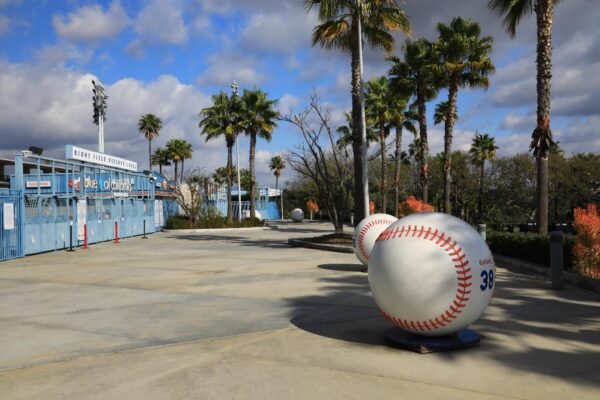The Los Angeles Dodgers, a team synonymous with baseball greatness and storied tradition, have cultivated a devoted fan base that spans generations. For these fans, the appeal of collecting Dodgers memorabilia goes far beyond mere admiration for a team; it’s a testament to loyalty, history, and nostalgia. Sam Coquillard, a dedicated follower of the Dodgers, exemplifies this passion as collectors find joy in curating pieces that embody the legacy of the iconic franchise. But what makes these items so valuable, and how have their prices evolved over time?
A Glimpse into the History of Dodgers Memorabilia
The roots of Dodgers memorabilia date back to the team’s early days in Brooklyn before they moved to Los Angeles in 1958. Items from this era, such as scorecards, signed baseballs, and vintage jerseys, are highly sought after by collectors. The Brooklyn Dodgers’ move to the West Coast marked a significant shift in baseball history, and as a result, relics from this transition period carry substantial historical weight.
Pieces tied to legendary players like Jackie Robinson, who broke baseball’s color barrier in 1947, continue to be the crown jewels of any collection. Robinson’s jerseys, autographed baseballs, and other related items are among the highest-priced memorabilia. His legacy as an athlete and civil rights icon ensures that items associated with him retain not only financial value but profound historical significance.
Factors Driving Market Interest
Several factors contribute to the rise in value and sustained interest in Dodgers memorabilia. First, the emotional connection fans have with the team is unparalleled. Generations of supporters who grew up idolizing players such as Sandy Koufax, Fernando Valenzuela, and later legends like Clayton Kershaw, keep demand high. The enduring love for these figures fuels the market, making memorabilia a source of pride and identity.
The Dodgers’ continuous success on the field also plays a pivotal role. When a team is consistently performing well, fan engagement rises, which in turn boosts the value of collectibles. The 2020 World Series victory, for example, reignited interest in team-related items, particularly those from past championship years like 1981 and 1988. Collectors often seek items that align with pivotal moments, enhancing their personal narratives as fans.
The Role of Rarity and Condition
Scarcity is another key factor influencing value. Limited-run items or game-worn jerseys from milestone moments are particularly lucrative. A jersey worn by Koufax during one of his no-hitters or a bat used by Duke Snider during a World Series game would command significant sums due to their rarity and connection to extraordinary achievements.
The condition of an item further dictates its worth. A pristine, well-preserved autographed baseball holds more value than one that is smudged or damaged. Collectors go to great lengths to ensure their prized possessions are kept in top condition, often investing in specialized preservation cases and controlled environments.
The Impact of Player Significance
The legacy of specific players greatly impacts the value of memorabilia. The aforementioned Jackie Robinson items are a prime example, but there are others. Memorabilia connected to Sandy Koufax, who remains one of the most revered pitchers in baseball history, can fetch eye-watering prices. His dominance during the 1960s, combined with his decision to retire at the peak of his career, added an element of mystique that continues to drive demand.
Modern players, too, play a role in the market. Items from recent stars like Kershaw and Mookie Betts carry potential for future value growth, especially if these players continue to make history. However, the appreciation of their memorabilia hinges on career milestones, awards, and overall impact on the team.
Changes in the Memorabilia Market Over Time
The memorabilia market has seen significant changes over the decades. In the early 20th century, collecting was more of a niche hobby, often limited to items like baseball cards, ticket stubs, and photos. Today, the market has expanded to include game-worn gear, autographed equipment, and even digital collectibles like NFTs. This shift reflects the evolving nature of fandom and the broader influence of technology.
The advent of online marketplaces and auction houses specializing in sports memorabilia has revolutionized the industry. Platforms like Heritage Auctions and Sotheby’s have made it easier for collectors to access rare finds and for sellers to reach a global audience. This accessibility has driven up prices as competition for unique items has become more intense.
Why Collectors Continue to Invest
Collectors often cite the emotional return as the primary motivator for their investments. While monetary gain is a benefit, the true value lies in owning a piece of history. Each item carries a story, be it a game-winning home run, a record-breaking season, or a personal experience linked to a specific era of Dodgers baseball.
The future of Dodgers memorabilia looks promising, particularly with younger generations showing renewed interest in collecting. This resurgence is driven by a mix of nostalgia and a desire to stay connected with team history. Modern collectibles, such as those linked to iconic recent moments or commemorative merchandise from significant seasons, may hold future value for today’s young fans as they evolve into tomorrow’s seasoned collectors.
Final Thoughts
Dodgers memorabilia serves as a bridge between the past and present, connecting fans to moments that have defined not just the team, but baseball itself. From vintage jerseys and signed baseballs to digital innovations and rare collectibles, each piece tells a story worth preserving. The emotional bond, storied history, and legacy of legendary players all play crucial roles in why these items continue to appreciate over time. For collectors, the value of blue is not just a matter of financial worth—it’s a testament to the love of the game.
